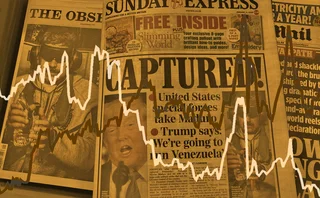
Accounting – a quant's job?
Quants have a new interest - developing accounting frameworks

When passionate, young individuals set out to complete advanced degrees in physics in the eighties, possibly with the ambition of researching string theory, they might not have imagined a future where they would have to price exotic derivatives driven by man-made rules. But it happened.
Even less likely was the possibility that some of them might one day turn into accountants.
Of all the valuation adjustments to have entered the market, the capital valuation adjustment (KVA) seems to be the most intimidating, checking all three boxes of being material in size, difficult to compute and lacking clear accounting guidelines. Although many dealers admit to charging their clients at least a part of the KVA, if not all of it, any questions on whether and how the measure should be accounted for have often been met with scepticism – and even annoyance – from traders and accountants.
The trouble with KVA is it is very firm-specific. Current accounting standards require banks to report their derivatives at fair value, which many have argued over the years should be based on the exit price, or the price paid for a derivative in an arm's-length transaction. But some believe the existence of an average market-observed cost of capital that can be used as an exit price is as theoretical as a unified field theory.
The growing complexity of the field is causing an increasing number of quants to step up and tackle the accounting problem – an area they have largely steered clear of in the past.
In this month's first technical Capital and funding, Claudio Albanese, chief executive officer of Global Valuation in London, Simone Caenazzo, a financial engineer at the same firm and Stéphane Crépey, a professor at the University of Evry in France, propose an accounting framework for KVA using ideas from Solvency II, a regulatory capital framework for the insurance industry, and International Financial Reporting Standard (IFRS) 4 phase II – an accounting standard for insurance contracts.
The quants equate KVA to something called risk margins under Solvency II. Risk margins – or the portion of capital coming from clients as opposed to shareholders – are classed as loss-absorbing capital. This differs from adjustments to fair value – the typical approach used for derivatives valuation adjustments – which feed through into capital. So the approach does not require the assessment of an exit price.
"In Solvency II, KVA is really entity-specific. It is not gauged on what the peers are doing," says Albanese.
According to the authors, the other valuation adjustments reflecting the counterparty credit risk, cost of funding and cost of initial margin, should be taken through reserve capital, which is treated as a liability, or contra asset, on the balance sheet that absorbs losses on an ongoing basis.
On the other hand, KVA is part of capital, as it is earmarked for paying dividends. So they argue it should be reported as part of retained earnings under Common Equity Tier 1 (CET1) capital, where it becomes part of capital and is slowly released over the life of the portfolio, since CET1 is meant for absorbing exceptional losses. This, they claim, takes care of the common practice of booking upfront profits and losses at trade inception, which should have been spread throughout the life of the trade.
A recent paper by Lloyds Banking Group's Chris Kenyon and Birmingham City University's Richard Kenyon offered a different take on the matter, arguing IFRS 13 does offer interpretations of fair value that are based on the cashflows of the project rather than observable market values. For instance, for an interest rate swap, the swap rate can be made to reflect the cost of capital seen as a cashflow of the trade. Under the pair's approach, KVA would be reflected in the fair value of the swap, which would flow through to earnings to be distributed to shareholders.
Albanese argues this could cause large write-offs if KVA is recognised at the start of the trade when a trader charges their client an amount below the hurdle rate for meeting return-on-capital targets. In this case, the fair value of the swap becomes negative at trade inception, although the cost should be incurred over its lifetime.
What regulators and auditors have remained silent on, arguably due to the complexity of an increasingly inter-disciplinary field, quants seem to have picked up.
In a panel discussion on April 13 at the Quant Europe conference in London, Youssef Elouerkhaoui, London-based global head of credit quantitative analysis at Citi, highlighted this shift in the role of quants. "A lot of the work that was traditionally done by balance sheet [and] treasury functions which was more statistical in nature and not as derivatives focused ... there is more involvement of front-office quants," said Elouerkhaoui. "We are not pricing exotic derivatives anymore."
This shift in interests has at least thrown open the debate on KVA accounting. Hopefully, other stakeholders are paying attention.
Only users who have a paid subscription or are part of a corporate subscription are able to print or copy content.
To access these options, along with all other subscription benefits, please contact info@risk.net or view our subscription options here: http://subscriptions.risk.net/subscribe
You are currently unable to print this content. Please contact info@risk.net to find out more.
You are currently unable to copy this content. Please contact info@risk.net to find out more.
Copyright Infopro Digital Limited. All rights reserved.
As outlined in our terms and conditions, https://www.infopro-digital.com/terms-and-conditions/subscriptions/ (point 2.4), printing is limited to a single copy.
If you would like to purchase additional rights please email info@risk.net
Copyright Infopro Digital Limited. All rights reserved.
You may share this content using our article tools. As outlined in our terms and conditions, https://www.infopro-digital.com/terms-and-conditions/subscriptions/ (clause 2.4), an Authorised User may only make one copy of the materials for their own personal use. You must also comply with the restrictions in clause 2.5.
If you would like to purchase additional rights please email info@risk.net
More on Markets
How JPM AM swapped platforms for pipes
Asset manager wanted to cut FX venues – and their fees – out of dealer relationships. Now, it only trades direct
Keeping inflation markets open if government shuts down
Last year’s US government shutdown upset inflation trades; an Isda band-aid helped but a longer-term fix is needed
Brokers must shift HFT servers after China colocation ban
New exchange guidance drives rush for “proximity colo” in nearby data centres
LatAm FX carry trade shrugs off geopolitical fears
Clients in regional carry positions remain undeterred by US interventions, say dealers
S&P bull run drives interest in reset and lookback hedges
Variable strike put options proved popular alternative hedging format of 2025
US mutual funds slash short euro positions at record pace
Counterparty Radar: Pimco cut $4.6bn of EUR/USD puts in Q3 amid changing stance on dollar direction
Nomura hires new global eFX head
Mark McMillan to oversee e-trading and sales activities in newly created role
Trump’s LatAm gambit spurs FX hedging rush
Venezuela op boosts risk reversals as investors look to protect carry trades







